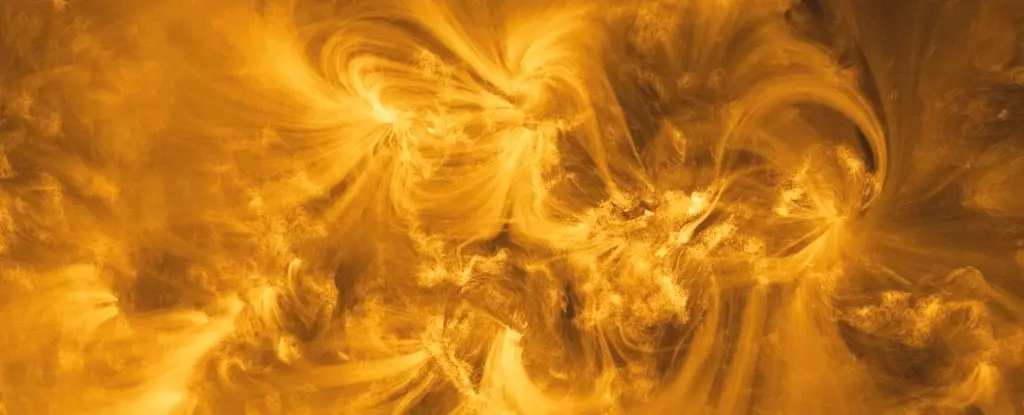At a staggering 74 million kilometers, the Solar Orbiter offers a groundbreaking perspective of the Sun, a celestial powerhouse at the heart of our solar system. Launched in 2020 as a collaborative endeavor by the European Space Agency (ESA) and NASA, the Solar Orbiter was designed with a specific mission: to unlock the mysteries surrounding our closest star. By investigating the solar wind, the magnetism that envelops the Sun, and its explosive phenomena—such as flares and coronal mass ejections—the mission aims to enhance our understanding of solar dynamics.
This distance may seem colossal when viewed through the lens of terrestrial standards; however, in astronomical terms, it serves merely as a stepping stone for the Solar Orbiter to capture unprecedented images and data about the Sun. This ambitious mission approaches the complexities of solar mechanics in ways that were previously unattainable, enriching both our scientific knowledge and our awe of the universe.
One of the standout features of the Solar Orbiter is its sophisticated suite of imaging instruments, specifically designed to obtain high-resolution images of the Sun’s surface and atmosphere. Using the Polarimetric and Helioseismic Imager (PHI), a German contribution, and the Extreme Ultraviolet Imager (EUI), which hails from Belgium, the Solar Orbiter has captured a series of images revealing the Sun in different electromagnetic wavelengths. This multifaceted approach allows scientists to probe deeper into the solar structure, almost as if peeling layers off an onion.
The newly released images are composite representations made from 25 individual pictures taken on the same day in March 2023. This meticulous assembly process ensures that researchers can analyze the Sun’s activity in unparalleled detail. By harnessing the power of these advanced imaging techniques, the Solar Orbiter provides a multi-dimensional view of our star, offering insights that can lead to profound scientific breakthroughs.
Understanding the magnetic field of the Sun is pivotal for comprehending the broader dynamics of solar behavior. According to Daniel Müller, the Project Scientist for Solar Orbiter, grasping the nuances of the Sun’s magnetic field can unveil the intricate tapestry of interactions occurring on both micro and macro scales. As the data from the PHI instrument reveals stunning maps of surface magnetic fields and plasma flows, the scientific community gains a clearer picture of solar phenomena, including the vital processes that govern the solar corona—an extraordinarily hot, outer layer of the Sun’s atmosphere.
Plasma movements on the solar surface reveal fascinating patterns, indicating regions of activity and energy transfer. By illustrating areas where plasma flows towards or away from the orbiter—color-coded in blue and red respectively—these findings contribute significantly to our comprehension of solar dynamics.
Among the array of captivating images, the ultraviolet captures from the EUI instrument stand out as particularly spectacular. These images showcase the dazzling spectacle of glowing plasma surging forth from sunspots, driven by complex magnetic forces. The superheated nature of this plasma gives viewers an ethereal glimpse into the Sun’s surface activity and the interactions that occur beneath.
Each image not only serves as a scientific tool but also as an artistic marvel. The mesmerizing visuals compel us to reflect not only upon solar mechanics but also on our own place within the cosmos, urging humanity to contemplate the complexities of life, the universe, and our shared evolutionary journey.
The Solar Orbiter’s mission encompasses a myriad of objectives, each providing unique contributions to our understanding of the Sun and its influence on the solar system. As advances in technology and imaging techniques continue, our comprehension of this celestial entity grows ever deeper. The images and data returned by the Solar Orbiter challenge us to think more broadly about our universe and foster a greater appreciation for the intricacies that govern it.
As we marvel at the sheer enormity of the cosmos, the captivating revelations from the Solar Orbiter serve as a reminder of our thirst for knowledge, encouraging ongoing exploration and inquiry into the wonders of the universe. In tandem with the pictures of our Sun, we are left with exhilarating questions, sparking an enduring curiosity about the nature of our existence and the cosmos at large.


Leave a Reply